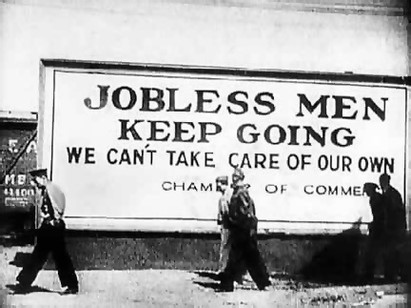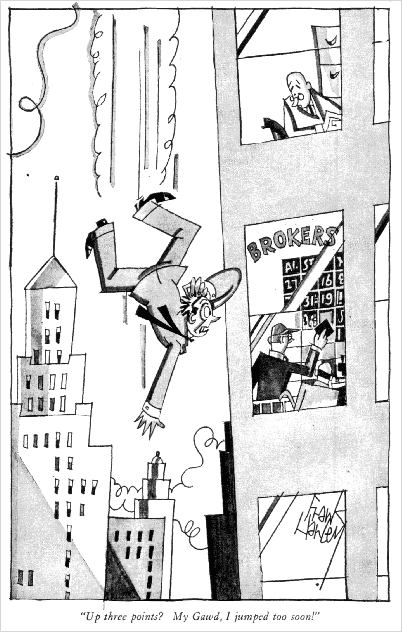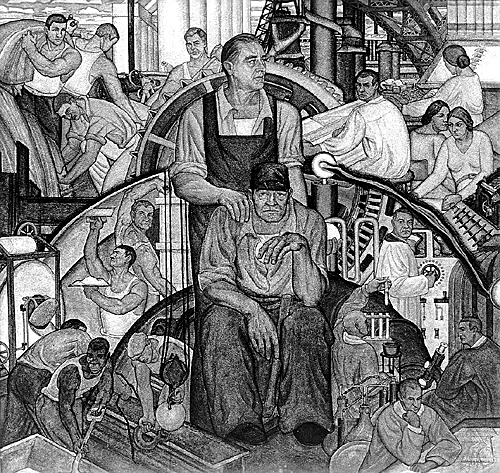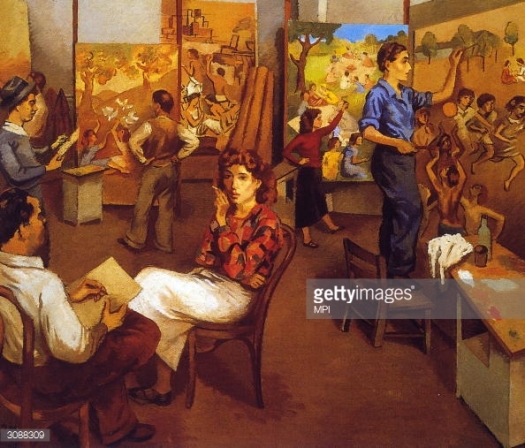
“This picture shows the impact the Great Depression had on the non-employed civilians, and how there were no jobs available.” (Farmers in the Great Depression)
You can’t hide the pain and no words can describe this great era of woe. This photo is worth far more than a thousand words. So, most just keep silent and keep walking.
Cartoons
Another way of depicting art is the cartoon and during times like the great depression cartoons can depict situations in a way that most people understand the meaning, but won’t shot the messenger. Such as someone possibly jumping of a building.

Piece: Up Three points
Artist: Frank Hanley
Created: January 10, 1930
“Up three points,” by Frank Hanley, is from January 10, 1930. It plays on the popular mythology of the time, according to which bankrupt stockholders were throwing themselves from the windows of New York skyscrapers in droves.” (Crabtree)
Never Fear; FDR is Here!
Franklin Roosevelt’s selection of the sunny Happy Days Are Here Again debuted at the 1932 Democratic Convention — by accident. Judge John E. Mack, the man who introduced Roosevelt, delivered a bland clunker of a speech and walked off stage to the originally chosen song, Anchors Aweigh. Roosevelt’s political advisors were so upset by the awful performance that they demanded a new song be played before the candidate’s speech. They selected Happy Days Are Here Again, from the 1930 musical Chasing Rainbows, making Roosevelt the first President to pick a pre-existing song for his campaign and handing the Democratic Party their unofficial theme song for years to come. (Suddath)
Doom and gloom covered America and America needed its own version of a superhero. It found it Franklin D. Roosevelt. The man who would do many things to shape our economy.

Piece: The New Deal
Artist: Conrad A. Albrizio
Style: Fresco
Location: dedicated to President Roosevelt, placed in the auditorium of the Leonardo Da Vinci Art School (149 East 34th Street, NYC) (ART GALLERY: THE GREAT DEPRESSION)
In this piece, we see FDR standing as the focal point. He has his hands on the poor worker who is in depression, inferring that hey I got your back. The rest of the picture depicts all the jobs that are opened to American citizens because of the new deal.
Lines, Linear perception, and balance:
Arches are used to separate different industries in the piece. they help to balance out the picture and create harmony with all of the different activities that are taking place. Depth is accomplished by visual layering and with so much going on I the piece, it is amazing how things don’t run over one and another.
Overall
I would not own this piece. It’s just not me. This would go good in a bank lobby.
Government Creating Jobs

Piece: WPA Artist
Artist: Moses Soyer
Created: 1938
Media: Oil on Canvas
Location: Hulton Fine Art Collection
To start to help America on her way back to recovery, FDR put out of work artist to work. Above is a painting of WPA artist. Theses government commissioned artist would go and spread joy to the people via their art, which they painted on public buildings. Ever wondered where some of that money comes from?

We can never insure one hundred percent of the population against one hundred percent of the hazards and vicissitudes of life, but we have tried to frame a law which will give some measure of protection to the average citizen and to his family against the loss of a job and against poverty-ridden old age. (Franklin D. Roosevelt, as quoted in (KITTY)
Ok, enough of my personal feelings. Back to the analysis of the WPA Artist painting:
Color and Tone:
Boring use of brown hues gives the feeling of overkill. Blues is used to give the picture a little spark and a dash of red to keep us honest. Dusty whites do not begin to help the scene and a bit of green to coincide with the fact that there’s still only a little money to go around.
Balance and Depth:
Despite my ill feelings to the colors of the piece, it is well balanced. It is obvious that the woman in the chair is the focal point as she is in the center of the foreground and the only one relaxing with a cigarette.
Overall
I would not own this piece. No emotion is felt when viewing it. Placement would be in a history department of a college or university.
Works Cited
ART GALLERY: THE GREAT DEPRESSION. 10 July 2010. 10 July 2017. <http://backthen-magna.blogspot.com/2010/07/art-gallery-great-depression.html>.
Crabtree, Cadwalader. The Great Depression in Cartoons, Part 1: . 12 January 2009. 10 July 2017. <http://www.archelaus-cards.com/archives/20090112.php>.
Farmers in the Great Depression. n.d. 10 July 2017. <http://kenyonchristian.weebly.com/photography.html>.
KITTY, KURIOUS. On Signing the Social Security Act of 1935. 5 September 2012. 10 July 2017. <http://kuriouskitty.blogspot.com/2012/09/on-signing-social-security-act-of-1935.html>.
Suddath, Claire. A Brief History of Campaign Songs. 2017. <http://content.time.com/time/specials/packages/article/0,28804,1840981_1840998_1840901,00.html>.
WPA Artist. n.d. 2017. 10 July 2017. <http://www.gettyimages.in/license/3088309>.hrefa

I really like your Early Modern Blog all of the images are fascinating and you did a great job of relating to the theme. It is hard to say that any appeal to me since it was such a painful time. But, I think the one that does appeal to me is the picture of the Farmers in the Great Depression. I think this picture really does capture what the Great Depression was to millions of Americans. I think what really appeals to me is the sign in the background. I think that one sign sums up the Great Depression as a whole. I think that picture does a great job of relating to the theme of the Great Depression. As easy of a theme as it was to find pictures and paintings for it was hard not to think about what happened as I was looking at all of them. It is just hard to think about what those people went through during that time. The picture of Farmers in the Great Depression sparked me to do some research on farming during the Great Depression. It was interesting to find out that over 750,000 farms were lost to bankruptcy and foreclosure. With the prices of their crops falling these farmers could not keep up on the payments for their farms or let alone make a living on how cheaply they were having to sell their crops.
LikeLike